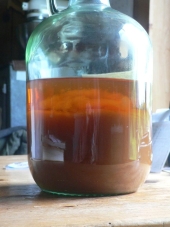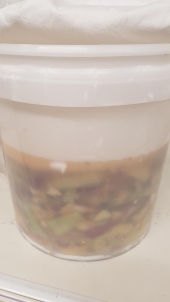
 3
3




Lisa
“Never does nature say one thing and wisdom another." ~Juvenal










 2
2










 4
4




 1
1




Lisa
“Never does nature say one thing and wisdom another." ~Juvenal
 1
1








Lisa
“Never does nature say one thing and wisdom another." ~Juvenal




Jay Green wrote:Why not just invest a little ingenuity into the project and make your own cider press?
http://www.instructables.com/id/How-to-make-cider/step6/Pressing-using-a-car-jack/
There are a few like this on YouTube as well.
After you have juiced your apples, you merely have to place this juice in a container~preferably glass or ceramic~cover the opening with an air permeable covering such as cotton or even a paper towel. Place the jug in a dark place and just let nature happen. The juice will pull mold/yeast spores from the air and will make it's own "mother" in due time. You can stir or swirl it every now and again to aerate it, but it isn't necessary.
Eventually you will have cider(think how quickly cider goes "hard"), then vinegar. After you have a good mother vinegar of your own, you can part it out into new jugs of juice to speed up the process of fermentation.


 1
1




Lisa Niermann wrote:do you just strain the apples/mush out at a certain point, then let it continue on to vinegar? Or just strain it when it's done?
 I just push the 'mother' back and dip a jug in. The solids eventually sink. When I was a kid we had a wooden wine barrel that we threw the windfall apples into year after year. I don't remember ever emptying it, but I suppose we did.
I just push the 'mother' back and dip a jug in. The solids eventually sink. When I was a kid we had a wooden wine barrel that we threw the windfall apples into year after year. I don't remember ever emptying it, but I suppose we did.
Lisa Niermann wrote:Is there an optimal apple:water ratio?
Lisa Niermann wrote:I don't want plastics leaching into my vinegar. Do you use something that is food grade material?
Lisa Niermann wrote:I wanted to start small to get a feel for what works
 2
2




![Filename: ACV-bucket-001.jpg
Description: [Thumbnail for ACV-bucket-001.jpg]](/t/16480/a/5763/ACV-bucket-001.jpg)
![Filename: ACV-bucket-002.jpg
Description: [Thumbnail for ACV-bucket-002.jpg]](/t/16480/a/5764/ACV-bucket-002.jpg)
Lisa
“Never does nature say one thing and wisdom another." ~Juvenal






 2
2




When you throw something away, there is no 'away'

 1
1




LaLena MaeRee wrote: I seen Leila say that cutting skins helps, so I just ran a razor around every single pear.





When you throw something away, there is no 'away'





LaLena MaeRee wrote: Maybe I can rig up a wall with a basin under it and let all the boys throw pears at the wall, that might be a fun way to break some up!
 2
2





 1
1




In my experience, vinegar is really tough. Even if it goes 'to sleep' I'd say it will be up and about again whatever you, or the temperature does!Jane Jones wrote: My main concern with Winter coming is how to keep it warm enough. We don't heat our house anywhere near the 80 degrees F I've seen mentioned as ideal vinegar making temperature! Has anyone had experience with how cooler temperatures might affect things?
 1
1





“Enough is as good as a feast"
-Mary Poppins






 1
1




![Filename: 2015-06-19-Apple-Cider-Vinegar.jpg
Description: [Thumbnail for 2015-06-19-Apple-Cider-Vinegar.jpg]](/t/16480/a/29173/2015-06-19-Apple-Cider-Vinegar.jpg)









... it´s about time to get a signature ...
 1
1








... it´s about time to get a signature ...








... it´s about time to get a signature ...




... it´s about time to get a signature ...
 1
1




Tobias Ber wrote:update: the technique works quite well. but it s important to stir the apple-pulp in the bucket every day or two to prevent mold.
and do not fill the bucket too high, because the solids will rise when the fermentation starts going off.
there is vinegar mother growing in the bucket and in the bottles, it will develop a few weeks after pressing/filtering the vinegar.
the ACV does not taste very well but will be good for household use.
will the taste get better over time?
-




... it´s about time to get a signature ...




... it´s about time to get a signature ...




Tobias Ber wrote:the ACV is quite cloudy. i ve used roadside apples. probably they were crab apples (sour and hard). they should be high in pektin which will cause the cloudiness (as far as i know).... but it seems to settle over time
-




... it´s about time to get a signature ...





www.ultimatepicklejar.com









|
Do not threaten THIS beaver! Not even with this tiny ad:
The new purple deck of permaculture playing cards
https://www.kickstarter.com/projects/paulwheaton/garden-cards
|








